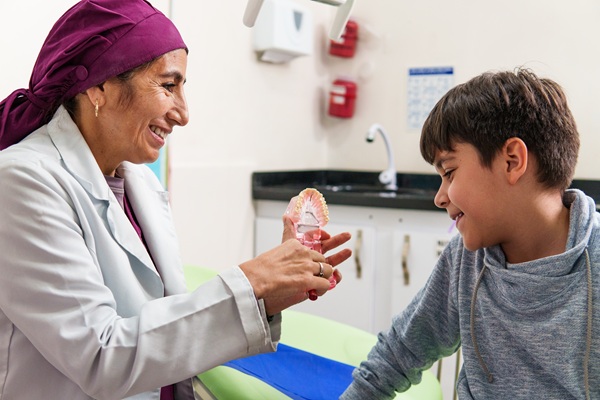The Role of a Pediatric Dentist in Your Child’s Health

Pediatric dentists care for children from infancy to adolescence. With specialized training and education in this age range, they teach young patients and their parents how to prevent oral health issues. They also diagnose cavities and gum disease in their early stages and administer treatments tailored to young patients. When these dental professionals establish good oral health habits early in a child's life, it can encourage them to maintain strong teeth and gums, reducing the risk of future dental issues.
Pediatric dental training and education
After finishing dental school, a prospective pediatric dentist undergoes additional training. This part of their education focuses on child psychology, growth patterns, and dental development. It gives them the tools to address the unique challenges associated with primary and permanent teeth. By understanding the differences between developing teeth and mature adult teeth, the pediatric dentist can provide appropriate treatments that align with a child's stage of growth.
This dental professional also learns how to manage a child's dental anxiety. With this knowledge, they can create a comfortable environment that encourages positive associations with regular dental visits and oral hygiene. They learn how to use gentle approaches, kid-friendly language, and a welcoming office setting to reduce young patients' fear and make dental care a stress-free and comfortable experience.
Preventive care and early treatment
Preventive dental care is a fundamental part of pediatric dentistry. For example, regular check-ups help patients monitor oral health and identify issues before they become serious and require extensive treatment. Preventive treatments like cleanings, flouride varnishes, and sealants protect teeth from cavities. Cavities are common among children due to their dietary habits, especially while they are still learning consistent oral hygiene routines.
Additionally, pediatric dentists also offer early treatment. They identify teeth and jaw misalignment, bite issues, and other developmental issues at an early stage, allowing them to recommend corrective treatments. An orthodontic evaluation can help the pediatric dentist determine whether the child may need future treatment, such as braces or space maintainers.
Treating common pediatric dental issues
While preventive measures can reduce the risk of oral health issues, children may still experience dental problems that require professional treatment. Some of the most common issues among pediatric patients include:
- Cavities
- Gum disease
- Tooth decay
- Dental injury or trauma
- Broken or knocked-out teeth
- Misaligned teeth
- Bad habits like prolonged thumb sucking and pacifier use
The importance of early dental visits
The American Academy of Pediatric Dentistry recommends that children have their first dental visit by their first birthday or within six months of the eruption of their first tooth. Early visits establish a routine of professional dental care and allow for the detection of any concerns. During these initial visits, the dentist assesses the child's oral development and checks for any signs of decay. When children are comfortable with these early experiences, they associate dental visits with positive emotions. They reduce anxiety and promote good dental habits into their adolescence and adulthood.
Routine visits every six months also allow pediatric dentists to monitor changes in a child's oral health and intervene when necessary. They may suggest that patients at a higher risk of tooth decay and gum disease visit the dental office more often. Nevertheless, this consistent dental care helps ensure that the child's oral development is on track while preventing minor oral health problems from becoming major problems.
Establishing good habits at home
During dental visits, pediatric dentists also teach parents how they can care for their little one's oral health at home. This home care varies based on the child's age.
- Children under 3 years old: Parents should help their child brush twice a day for two minutes with a soft toothbrush and a grain-sized bit of flouride toothpaste.
- Children who are 3 years old and older: During this stage in their development, parents should help their child brush twice a day for two minutes. They should use a pea-sized amount of flouride toothpaste and encourage the child to spit it out. When the child has teeth that touch each other, they will need to learn how to floss once a day.
- Children who are 10 years old and older: Children at this age can usually be trusted to brush and floss on their own. They may need reminders to brush twice a day for two minutes and floss once a day.
Pediatric dental care instills lifelong responsibility and awareness of proper hygiene habits. When children learn the importance of brushing, flossing, and making healthy dietary choices, they are more likely to carry these habits into adulthood.
Schedule your child's next visit
Pediatric dentists are an essential part of children's oral health. Early and consistent visits with this dental professional can instill positive experiences that encourage lifelong dental health. Call our office to learn more about our pediatric dental services or to schedule your child's next visit.
Request an appointment here: https://whiteflintfamilydental.com or call White Flint Family Dental at (301) 273-1085 for an appointment in our Rockville office.
Check out what others are saying about our dental services on Yelp: Pediatric Dentist in Rockville, MD.
Recent Posts
Regular pediatric dental checkups can help determine if your child needs a dental filling. Kids tend to eat more carbohydrate-rich foods. The starches and sugars tend to feed bacteria in the mouth, making them produce more acids. This results in weak enamel and cavity formation. A dental filling can restore your child’s teeth. If you…
Tooth decay is one of the most common oral health issues experienced by children. A pediatric dentist can help your child develop a proper oral hygiene routine that may prevent serious consequences, such as problems with speaking, eating, learning, and playing.According to the Centers for Disease Control and Prevention, 20% of children have a decayed…
Pediatric dentistry sometimes uses treatments like root canals to treat primary teeth. Root canals are used to treat tooth infections and to save severely damaged teeth. Performing a root canal allows the dentist to treat the tooth without having to perform an extraction.Primary teeth serve as placeholders for permanent teeth, and orthodontic issues like impacted…
Should children be seeing a family dentist or a pediatric dentist? While many adults and teenagers see a general or family dentist for all dental concerns, is that the best choice for children? This decision is a dilemma that many parents face as young children begin to develop baby teeth. While for some parents the…


